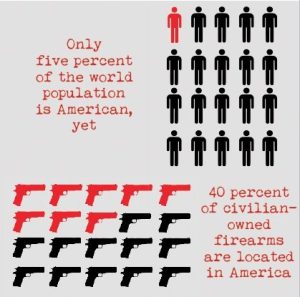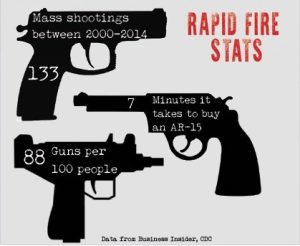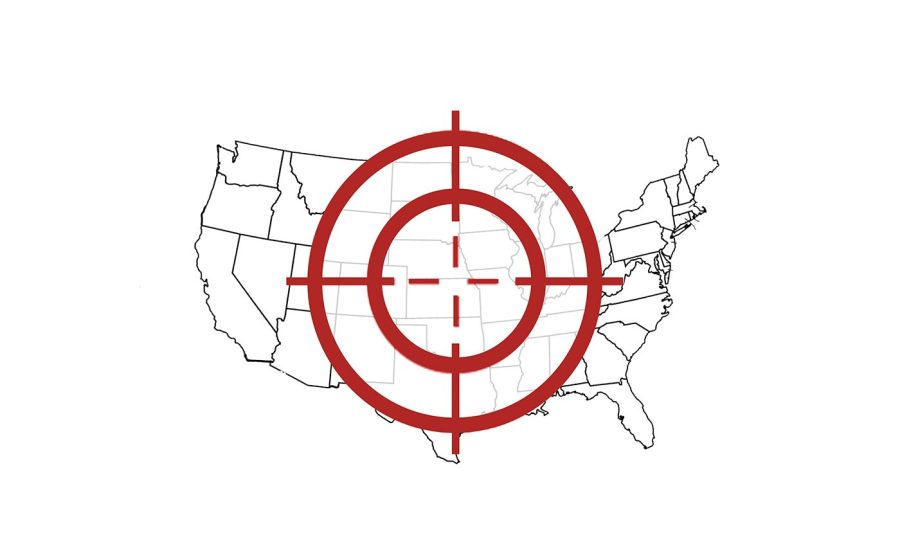[divider]Intro[/divider]
Apr. 16, 2007 — 32 killed at Virginia Tech University. Dec. 14, 2012 — 27 killed at Sandy Hook Elementary School. Dec. 2, 2015 — 14 killed in San Bernardino, Calif. June 12, 2016 — 49 killed in Pulse Nightclub in Orlando, Fla. Oct. 1, 2017 — 58 killed at a concert in Las Vegas, the deadliest mass shooting in the history of the United States. Nov. 5, 2017 — 26 killed in a Texas church. The list goes on and on.
[divider]Breaking Down the Problem[/divider]
Number of Guns
America loves two things more than anything — being first and owning guns. When you put the two together, it logically follows that Americans should own the most guns. And it’s true. A United Nations study found that the U.S. has a gun ownership rate of 88.8 guns per 100 people — by far the highest of any nation. War-ravaged Yemen comes in second place with 54.8 guns per 100 people. To put this number into further perspective, the U.S. is home to 5 percent of the world’s population, but 40 percent of all guns.
Some believe that this strongly correlates with the fact that gun violence claims the lives of 80 people a day, according to the Center for Disease Control (CDC).
One of the central points of conflict in the gun debate is whether more guns leads to more violence or in fact deters violence. The U.S. makes for a great case study because they have a lot of guns, as shown by the numbers. But evidence also shows that the U.S. has more gun violence, which would directly support the claim that more guns equals more violence. For example, the murder rate in the U.S. is 15 times higher than any other developed nation, and a 2014 study published by the International Journal of Criminal Justice Sciences found that the U.S. suffers from mass shootings at a rate 11 times greater than any other developed nation.
However, the most crushing blow to this argument comes from research presented in a Nov. 5, 2017 Vox article. In a detailed analysis of developed nations, a strong, positive correlation was found between number of guns and number of gun related deaths. This trend held true for individual states in the U.S. as well, and similar results were obtained by various independent researchers, such as the Harvard School of Public Health and the National Institute for Biotechnical Information (NCBI).
On the other hand, a strong argument in favor of gun ownership is self defense. Proponents claim that if more people were armed, they would be able to defend against mass shooters before they had an opportunity to fire. In fact, after the Sandy Hook shooting in 2012, the National Rifle Association (NRA) argued for more guns on school campuses. Secretary of Education Betsy DeVos has made similar claims about the value of firearms as a safety precaution.
Yet, repeated simulations and research have shown that in the heat of the moment, people are unable to stop an active shooter. A simulation conducted at Mount St. Mary’s University in 2015 took average students with varying ranges of skill, trained them and placed them in a classroom. When the moment arrived, many fumbled to pull out their gun, and struggled to keep the peace and prevent violence from breaking out. The study found that without years of skill and training with guns, as well as experience in high-pressure combat scenarios, it would be impossible for a civilian to defend themselves

“The theory that armed citizens should be better able to defend against crime is not wrong — there’s nothing illogical about it,” said a senior in a survey conducted by The Campanile. “But the problem is the data just proves otherwise, and you can’t argue with reality.”
While there might have been some incidents where an armed civilian was able to prevent a shooting, in the end, evidence points towards the conclusion that more guns leads to more violence. Unfortunately, the U.S. has more guns than the next 18 nations combined, and it doesn’t look like these numbers are going down anytime soon.
Second Amendment
America’s love-hate relationship with guns is rooted in the Constitution, specifically the Second Amendment. It reads, “a well regulated Militia, being necessary to the security of a free State, the right of the people to keep and bear Arms, shall not be infringed.” These seemingly-innocent words have been at the heart of one of America’s most lengthy and polarizing debates.
Two prevailing fields of thought emerge from the wording of the Second Amendment. The individual rights theory argues that the wording directly implies the right for an individual, with or without affiliation to an organized militia, to own a firearm, and any action from Congress that prevents this can be deemed unconstitutional. Another theory, known as the collective rights theory, argues that the wording “a well regulated Militia” implies that the Framers only intended to give this right to states, as a means of self defense against federal aggression. Thus, only groups, not individuals, have the right to possess firearms, and any attempt to limit this from individuals is germaine.
According to AP U.S. History teacher Jack Bungarden, the intention of the founding fathers is something that Americans have debated over for decades, but no consensus has been reached. Gun policy and attitudes towards firearms fluctuated throughout the 19th and 20th centuries, but a significant turning point occurred in the 1970s.
“The NRA used to be for gun control, but in 1977 in Cincinnati, a radical minority took over the NRA, shaping it to be as we know it today.”
Jack Bungarden
In essence, the NRA used to promote legislation to foster safe practices with regards to firearms, but ever since the gun rights advocates took over the NRA, it has become a large lobbyist in Congress and has endorsed less gun regulation.
On the other side of the argument, gun control advocates often point to the increased power of modern weapons. When the Second Amendment was written, weapons such as the AR-15 and other semi-automatic handguns that could fire far over 100 rounds a minute were a figment of the imagination. The rifles used at the time when the Second Amendment was written took a trained soldier almost half a minute to fully reload. Only holding one shot at a time, these rifles were significantly less accurate — and therefore less deadly — than modern firearms.
Regardless of interpretation, it is undeniable that while our weapons have modernized, our laws have not.
The Second Amendment has also had a tangible role in shaping Supreme Court decisions with far-reaching impacts. Most notably is the 2008 case District of Columbia v. Heller. In 1976, the District of Columbia enacted one of the nation’s toughest gun control laws, banning all handguns, automatic firearms and high-capacity semiautomatic weapons. Murder rates declined, preventing almost 50 deaths per year. But in 2008, the Supreme Court struck this law down deeming it unconstitutional as it violated the Second Amendment. Since then, murder rates have stabilized, but only time will reveal how they are affected by the absence of strict gun control. The precedent set by Heller has two broad impacts: the Supreme Court siding with the “individual rights theory” of the Second Amendment, and the legal precedent to strike down any future legislation that attempts to curtail access to guns.
Loose Background Checks
Another important factor fueling America’s gun epidemic is notoriously loose background checks. The logic is quite straightforward: lax laws lead to more guns in society, which lead to more deaths.
According to GunPolicy.org, when compared to other developed nations with low homicide rates such as Australia, Canada and Germany, the U.S. is lacking when it comes to gun control laws. All three of these nations require the owner to obtain a license, register the gun, have a valid reason for buying the gun, enroll in a safety training program and sign a safe storage agreement. The U.S. has none of these regulations.
Take a closer look at Australia. In 1996, the deadliest massacre took place in Australian history when a man open fired in a cafe in Port Arthur, killing 35 and wounding 23 more. Immediately after, the Australian government responded with legislation banning automatic and semi-automatic guns, initiated a buyback program that collected 650,000 guns and also started a national registry. While gun violence (homicides, suicide, domestic violence) has reduced drastically overall, the key statistic to look at is that of mass shootings. In the 18 years prior to Port Arthur, 13 mass shootings took place. In the 14 years after legislation — none.
Research from Harvard University has found that one out of every five guns is bought without a background check. The largest holes occur in online sales, private sales and guns obtained from friends and acquaintances. For example, in 31 states, a father can pass a gun along to his son without any sort of background check being mandated. Gun shows present another loophole, where gun transactions occur with no background checks.

The Gifford Law Center explains that due to a lack of federal laws, the burden falls on individual states to create a strong network of laws to prevent the wrong people from accessing guns. Their research shows that not only do states with stricter gun laws have less violence, but stronger gun control laws help prevent gun trafficking and other crimes.
But in the U.S., it is quite easy to obtain a gun. An October 2017 Business Insider article details just how simple it is to buy one. In fact, the publication’s reporter was able to walk into a store and leave with an AR-15 (the same gun used in the Orlando shooting in June) in a mere seven minutes.
Most sales consist of a federal and state check. If you don’t have a criminal record and meet a few other simple criteria, you’re good to go. No wait time, no further questions. And that’s just the public sales involving a dealer. Private sales are a whole other ballgame, and are even less scrutinized.
“Gun violence and mass shootings are both immense problems in the U.S. and a large part of the issue is the lack of gun regulation. We absolutely need to reform our gun laws to ensure that people undergo a more thorough background check before being able to buy a weapon. For instance, we need to look into past histories of domestic violence.”
Soumya Jhaveri
Modern guns are high-grade military equipment, normally used by people who have trained for years and understand the circumstances in which deadly force is justified.
In no other developed country are guns sold to civilians without proper checks into the purchaser’s history, and many countries also require buyers to learn basic firearm safety beforehand. Guns are falling into the wrong hands and stricter background checks might be the solution to curbing this.
Mental Illness
Mental illness is perhaps the phrase most often associated with mass shootings, but new developments are showing that mental illness may not actually be a good predictor of gun violence. In fact, mental illness is most often used as a scapegoat, a myth perpetrated by the media and gun lobby, according to Jonathan Metzl, professor of psychiatry, sociology, and medicine and health,at Vanderbilt University. And people believe it. In a 2013 Gallup Poll, 80 percent of respondents believe mental illness is at least partially to blame for mass shootings, and more people believe mass shootings result from a failure of the mental health system than the abundant access to guns.
Metzl’s research is breaking stereotypes held against the mentally ill. It shows that people who are mentally ill are more likely to be victims of gun violence rather than culprits. Additionally, research by Jeffrey Swanson of Duke University shows that this group of individuals are only responsible for 3 to 5 percent of all violent acts.
But the overall thesis of both Swanson’s and Metzl’s work is that there are better predictors of a mass shooting than mental illness, though in the end, there is no guaranteed measure. Most prominent on this list is drug and alcohol abuse. Repeated national and international studies of thousands of people have clearly and consistently shown that substance abuse is a strong indicator of potential gun violence.
One example is from Swanson’s research in 2002 across four states. By tracking patients of psychosis or a major mood disorder, Swanson found that “the number who committed a violent act that year was 13 percent. But the likelihood was dependent on whether they were unemployed, poor, living in disadvantaged communities, using drugs or alcohol, and had suffered from ‘violent victimization’ during a part of their lives. The association was a cumulative one: take away all of these factors and the risk fell to two percent, which is the same risk as found in the general population.”
At the end of the day, yes, there is a connection between mental illness and shootings. But is it as big as the media makes it to be? Absolutely not. The attention mental illness has gotten in light of recent mass shootings is unfair, and as a result, background checks, which now mainly focus on mental illness, are severely lacking. A person’s likelihood to be involved in a mass shooting is definitely based on their past, but is a compound of factors, not solely their mental health.
[divider]What has Paly done?[/divider]
Paly has taken many measures to protect our campus in case of active shooter; however, there is always room for improvement.
“I don’t think any school can ever be really ready or prepared completely.” said Assistant Principal Janice Chen, who oversees the school safety plans. “I think that the drills are really important to take seriously, and in the last drill at the beginning of the school year the majority of our students and faculty definitely took it seriously. Is there room for improvement? Yes, but I think for the most part we know what to do when and if a situation like that happens.”

According to Jhaveri, based on the frequency of recent shootings, the possibility exists that one may occur near us at any time.
Chen assuaged these concerns by discussing steps Paly can take to ensure the safety of its students
“One way to prepare for any type of emergency is to practice when it’s unscheduled, when people aren’t prepared for it,” Chen said. “Even our fire drills too, same thing. We all know when it’s scheduled, what to do, but if we want to get really good at it, we have to do it when it’s not scheduled.”
[divider]Solution[/divider]
There are still many unknowns in this complex equation of individual rights, gun control laws, constituent safety and government responsibility. Whether you believe concealed carry deters or increases violence, or if the Second Amendment should or shouldn’t apply to the modern guns of today, the fact still remains that the U.S. has an unparalleled problem with gun violence. Unfortunately, there is no easy solution.
Every scenario is unique and, as Swanson puts it, the factors responsible for mass violence are messy, complex and dynamic. There is no one-size-fits-all solution, but this doesn’t mean we shouldn’t take proactive steps.
First and foremost, we have to realize that no one side is 100 percent right. There will be examples of cities in which guns helped and examples in which guns didn’t. Data will fluctuate from year to year. If we want to make progress, we will have to compromise.
It’s important to note that mass shootings actually represent only a small fraction of gun violence. Homicides and suicides make up a larger proportion of gun deaths — around 11,000 and 20,000 respectively.
Gun control is often launched into the national spotlight after a mass shooting, and ironically, this article targets mass shootings because of their prominence, but gun control is necessary to limit the deaths that occur everyday but go unmentioned on the nightly news.
However, if we want to reduce mass shootings, we have to limit access to high caliber weapons. We have to strengthen background checks across the board at a federal level so that no one can purchase 33 guns in a calendar year and walk into a Las Vegas hotel room undetected.
We have to improve the screening process before guns are issued, looking into not just criminal and asylum records, but also other strong indicators of violence such as alcohol abuse. We have to close loopholes in policy that allow the shooters to obtain weapons such as at gun shows and through private sales.
It is undeniable that the gun situation is not black and white or good and bad, but rather spans the murky gray area in between. In no way is one side at fault, but the status quo is not a sustainable model for either side of the spectrum.
The violence caused by guns is so diverse that it is often stated that America does not have just one gun problem but multiple gun problems. Just like the problem has many folds, the solution will also have many folds, and it is imperative that we put down our guns, set aside our differences and start moving towards a solution today.

